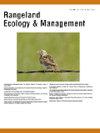南非干旱区灌丛物理结构和密度对大气梯度的响应
IF 2.4
3区 环境科学与生态学
Q2 ECOLOGY
引用次数: 0
摘要
驯养的中草食动物对牧场的转变遵循状态-过渡模型,这一假设允许植被跨越生态阈值的预测。我们通过试图确定Gamka灌丛的结构阈值来检验这一假设,Gamka灌丛是南非奥尔巴尼灌丛的结构异质变异。在不同的草地管理历史中,我们将灌丛的物理结构和密度与距人工浇水点的距离联系起来。此外,我们还比较了在我们的大气层处理的末端区域转化的模式、程度和变化,并与转化和未转化的参考点进行了比较。丛丛1.5 m以下密度和叶质量的变化表明,中草食动物对丛丛结构产生了深刻的影响。然而,证据还不足以表明灌木丛的物理结构发生了不可逆转的变化,因此已经越过了结构阈值。对我们的抽样设计的一个有用的补充是包括沿大气层梯度的围合图。本文章由计算机程序翻译,如有差异,请以英文原文为准。
Responses in the Physical Structure and Density of Bush Clumps on Piosphere Gradients in an Arid Thicket Mosaic, South Africa
The hypothesis that transformation of rangelands by domestic mesoherbivores follows state-and-transition models allows for the prediction that the vegetation could cross an ecological threshold. We examine this hypothesis by attempting to identify structural thresholds in Gamka Thicket, a structurally heterogeneous variation of Albany Thicket in South Africa. We relate the physical structure and density of thicket bush clumps to distance from artificial watering points in four piosphere treatments differing in rangeland management history. Furthermore, we compare the pattern, extent, and variation in transformation at the end regions of our piosphere treatments with each other and with a transformed and untransformed reference site. Changes to the density and leaf mass below 1.5 m of bush clumps indicate that their structure is profoundly altered by mesoherbivores. Nevertheless, the evidence is not sufficient to indicate that irreversible changes in the physical structure of bush clumps have taken place and therefore that structural thresholds have been crossed. A useful addition to our sampling design would be to include exclosure plots along the piosphere gradients.
求助全文
通过发布文献求助,成功后即可免费获取论文全文。
去求助
来源期刊

Rangeland Ecology & Management
农林科学-环境科学
CiteScore
4.60
自引率
13.00%
发文量
87
审稿时长
12-24 weeks
期刊介绍:
Rangeland Ecology & Management publishes all topics-including ecology, management, socioeconomic and policy-pertaining to global rangelands. The journal''s mission is to inform academics, ecosystem managers and policy makers of science-based information to promote sound rangeland stewardship. Author submissions are published in five manuscript categories: original research papers, high-profile forum topics, concept syntheses, as well as research and technical notes.
Rangelands represent approximately 50% of the Earth''s land area and provision multiple ecosystem services for large human populations. This expansive and diverse land area functions as coupled human-ecological systems. Knowledge of both social and biophysical system components and their interactions represent the foundation for informed rangeland stewardship. Rangeland Ecology & Management uniquely integrates information from multiple system components to address current and pending challenges confronting global rangelands.
 求助内容:
求助内容: 应助结果提醒方式:
应助结果提醒方式:


